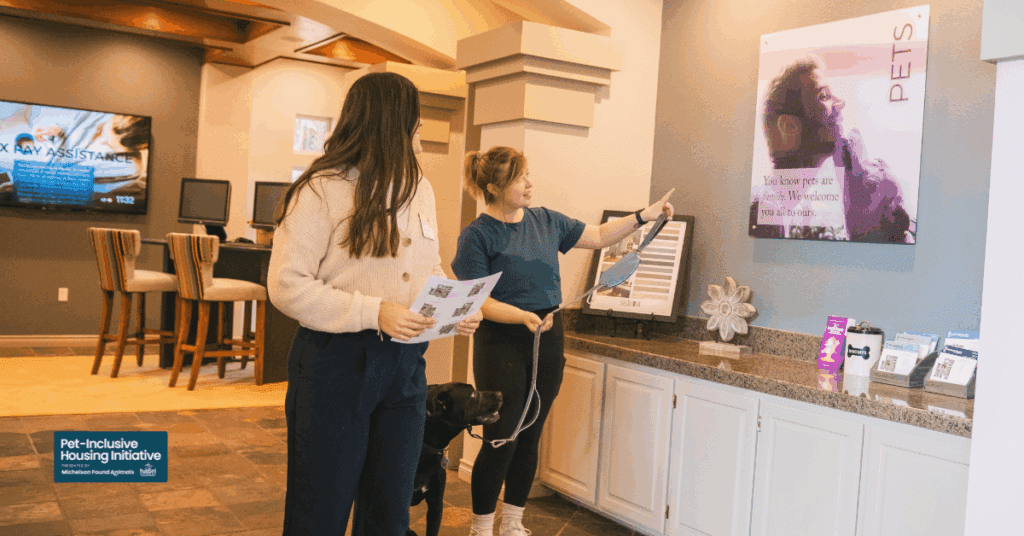
By The Pet-Inclusive Housing Initiative
We have recently seen pet proptech platforms introduce new AI tools designed to help multifamily housing providers better evaluate emotional support animal (ESA) accommodation requests. These tools are also being used to drive compliance by identifying unknown and unregistered pets in multifamily buildings. This kind of tech-forward solution may seem like the answer to curbing suspected ESA fraud when renters have their pets declared ESAs to avoid pet fees or breed and weight restrictions.
But the truth is, many multifamily housing providers may be investing in expensive tools to solve a problem they can solve on their own.
At the Pet-Inclusive Housing Initiative, we’ve been exploring what drives ESA accommodation requests. We’ve conducted original research, collaborated with operators nationwide, and listened to renters. The evidence is convincing: restrictive pet policies are a major reason renters turn to ESA designations in the first place. If the goal is truly to prevent unnecessary ESA requests, providers don’t need to start with artificial intelligence. They can start with more pet-inclusive policies.
Yes, Fraud Does Happen – But So Do Workarounds
Let’s be clear: some ESA requests are submitted without proper documentation or verification. Housing providers have legitimate businesses to run and deserve tools to navigate accommodation laws effectively.
But let’s also be honest: many of the so-called “fraudulent” ESA requests are coming from renters who simply want to live with their pet – something that’s made needlessly difficult by widespread breed and weight restrictions. Our 2025 ESA survey of renters found that:
- 41% of respondents said housing reasons influenced their decision to have their pet declared an ESA.
- 22% said a housing reason was the most important factor.
- And 48% of those respondents cited breed or weight restrictions specifically.
These are renters who feel backed into a corner. And given that 97% of pet owners view their pet as family, can we really be surprised that people try to keep them, one way or another?
The Easier, Proven Prevention Strategy: Remove the Trigger
One of the biggest drivers of ESA designation isn’t deceit – it’s policy avoidance. Many renters are trying to escape arbitrary rules or excessive costs. Most rental housing in the U.S. imposes breed or weight restrictions, and less than 10% of rental properties are truly pet-inclusive, without breed or weight restrictions.
When housing providers lift these barriers, the volume of ESA requests should drop. K. David Meit, Principal at Oculus Realty, put it best:
“When your community is pet-inclusive, the need for resident deceit drops dramatically. At Oculus Realty, we found that even when more than half of our residents had pets, only a tiny percentage used an ESA, which we thoroughly evaluate and reassess annually. There is simply no need for a fake ESA letter.”
This approach works and has operational benefits. Pet-inclusive policies can lead to:
- Fewer ESA requests and disputes
- Longer tenures (pet owners stay 21% longer on average)
- Lower turnover costs and vacancy losses
- More connected communities (pet owners engage and build relationships)
But What About Property Damage? The Risk is Manageable
One common concern about lifting breed and weight restrictions is property damage. But the data suggest this fear is overblown.
- According to PetScreening’s 2024 report, property managers report an average of $596 in pet damage, with 28% of pet-occupied units showing any damage.
- Meanwhile, PIHI’s 2021 report shows renters report just $210 in damage on average, and only 9% of pet-occupied units reporting any damage at all.
The true number likely lies between those estimates, but either way, over 70% of units with pets do not experience pet-related damage, and when they do, the costs are typically covered by standard refundable deposits.
Step One: Check Your Insurance. Step Two: Drop Your Restrictions.
Some providers worry that their insurance policies require breed or weight bans. But that’s not always the case.
Our Insurance Discovery Tip Sheet offers a step-by-step guide to checking whether breed and weight limits are truly required or simply assumed. Many carriers focus on individual pet behavior, not arbitrary characteristics. If your policy has restrictions, you can ask:
- Are these mandatory or just advisory?
- Can we add an endorsement or rider for broader coverage?
- Where’s the data backing up the restriction?
Chances are, your insurer may already allow more flexibility than you think.
The Next Frontier: Rethinking Pet Fees
Removing breed and weight restrictions is a powerful first step in reducing unnecessary ESA requests, but it’s not the last.
Pet fees, especially non-refundable ones and pet rent, are another major driver of ESA designations. When renters face hundreds or thousands of dollars in extra costs just for having a pet, they have a strong incentive to pursue ESA accommodations.
As our recent blog, “Rethinking Pet Fees,” explores, many of these fees are not rooted in actual cost recovery. They are a revenue strategy that can backfire by pushing renters to find loopholes. The next evolution in pet-inclusive housing is to align pet-related costs with actual risk and fairness, rather than maximizing penalties for pet ownership.
A Call for Smarter, Simpler Solutions
Multifamily housing providers don’t need to invest thousands in AI tools to stem the tide of ESA requests. They need to eliminate the most common reasons renters feel compelled to seek ESA designation in the first place.
That starts with:
- Auditing insurance policies for flexibility
- Eliminating breed and weight restrictions
- Preparing to rethink pet fee structures
ESA fraud is a solvable problem. But solving it starts not with algorithms, but with empathy, data, and good policy.
For evidence-based tools, insights, and templates, visit petsandhousing.org.
